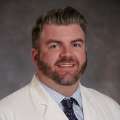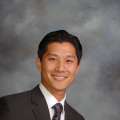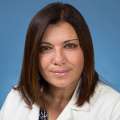In the 20 years since 9/11, more than 110,198 responders who came to Ground Zero from every state, and survivors who were living, working or attending school within the “exclusion zone” have enrolled in the Center for Disease Control and Prevention’s World Trade Center Health Program.
They suffer from a multitude of ailments that include chronic rhinosinusitis, pulmonary disease, gastroesophageal reflux disease (GERD), asthma, sleep apnea, post-traumatic stress disorder, anxiety, depression and cancer. Of those who registered with the program, 4,343 have died.
Two decades later, doctors continue to learn new things about the lingering health impacts on people’s lives.
“We’re still in prime time for learning what the long-term consequences are going to be,” says Russell G. Buhr, MD, PhD, assistant professor of pulmonary and critical care medicine, who has treated National Guardsmen who were at Ground Zero. “We still have a lot to learn. Whether it’s 9/11 or the wildfires of California, something like this will help us understand how to mitigate the health risks of other crises.”
Seeking answers
Three days after terrorists flew two jumbo jets into the World Trade Center on September 11, 2001, collapsing the Twin Towers and killing nearly 3,000 people, television journalist Scott Shulman boarded a corporate jet in Los Angeles to fly to New York to cover the national tragedy.
For nearly two weeks he stayed at Ground Zero, working 12-hour shifts operating a satellite uplink truck to feed reports and images of the recovery efforts back to his network. “It was a smoking pile for weeks,” Shulman says. “We were constantly breathing smoke, ash and dust.”
The crumbling skyscrapers spewed a toxic blend of jet fuel, glass, paint, concrete and steel that contained a host of known carcinogens — asbestos, beryllium, benzene, among others — that hung in the air for weeks. Few knew the danger of breathing suspended particulate matter.
“Today, every single recovery worker would be wearing an N-95,” Shulman says. “But nobody was wearing masks back then.”
Chronic rhinosinusitis, which affects 15% of the U.S. population, is the top certified condition of the WTC Health Program; 32,925 people registered for that condition. Shulman’s seemingly endless sinus infections began a year after; they got so bad, that the infections eventually led to bone loss in his jaw and the loss of one of his teeth.
“I basically had a sinus infection for 17 years,” says Shulman, who this year retired as a network news producer.
Jeffrey D. Suh, MD, associate professor of head and neck surgery, began treating Shulman for sinusitis in 2018. He corrected Shulman’s deviated septum and performed endoscopic surgery to open up his sinuses. “With the massive amount of chemicals, pollutants, dust, mold — everything that would be in those buildings — it could make someone who already did have sinus problems worse, or someone who never had sinus problems start. It would definitely exacerbate things,” Dr. Suh says.
But Shulman’s problems were not limited to his sinuses. He also suffered pain and inflammation in his throat, and a persistent cough. “I knew by 2002 that my health was being affected, but I couldn’t put my finger on it,” he says.
Seeking answers, he underwent several medical exams and procedures. Finally, in 2017, a CT scan of his heart that he had while preparing for shoulder surgery led to a frightening finding: His lungs were filled with nodules. Doctors told him he had what appeared to be a rare inflammatory disease called sarcoidosis.
Shulman and his wife, Cipra, were terrified when they heard the news. “We didn’t know if I was living or dying when I saw these nodules in my lungs,” Shulman recalls. “We looked at each other — we didn’t know if it was leading to a cancer diagnosis or if it was going to get worse or better.”
He found his way to Joseph P. Lynch III, MD, Holt and Jo Hickman Endowed Chair of Advanced Lung Disease and Lung Transplantation at UCLA, who is an expert on sarcoidosis. Dr. Lynch confirmed the diagnosis and spent 90 minutes explaining the condition to the couple.
“Sarcoidosis can kill you if it gets into your heart. It’s an auto-immune disease. It’s your body trying to rid itself of these toxic dust remnants,” Shulman recalls. “It is stealthy, and odd, but it was incredibly comforting to know that Dr. Lynch was looking out for me.”
Treating physical and mental health
Shulman is among six 9/11 patients Dr. Lynch has treated. Though UCLA is 3,000 miles from the scene of the event, its pool of medical experts has treated people from near and far suffering the health consequences of 9/11’s aftermath.
Among them have been combat veterans of the post-9/11 wars in Iraq and Afghanistan, who continue to receive treatment through UCLA’s Operation Mend and FOCUS: Families OverComing Under Stress. UCLA has also been pivotal in helping children of 9/11 responders and survivors cope with trauma and stress.
“September 11 really shook our concept of what is safe,” says psychologist Melissa Brymer, PhD, director of terrorism and disaster programs for the UCLA-Duke National Center for Child Traumatic Stress, which was awarded federal funding on September 11, 2001 and began operating the next month. “It made us feel vulnerable in terms of how our lives could change so dramatically.”
Dr. Brymer emphasizes the importance of coordinating efforts to make sure the people who are affected by a crisis such as 9/11 receive both physical and mental health treatment. “We’re 20 years out, and the data are showing that people are still not getting access to the services they need,” she says. “We need a longer timeline to make sure people are getting high quality health and mental health care and that we make these services accessible for all impacted.”
In January 2018, Shulman presented his case to a CDC panel, which would review his medical records and decide if his health conditions were related to his exposure at Ground Zero. If the panel decided in his favor, his care would be covered by the WTC Health Program. A few months later, Shulman was accepted into the WTC Health Program for three 9/11-related conditions: interstitial lung disease (sarcoidosis), rhinosinusitis and GERD, the cause of his painful reflux.
“It felt like this incredible validation, after 17 years, that what I was going through was due to my exposure,” he says.
What we’re learning
Dr. Buhr is particularly concerned about the lag time between environmental exposure and the appearance of disease. “You breathe on average somewhere between five and 15 liters of air every minute of every day, awake or asleep, and everything in that air touches the inside of your lungs,” he says.
This can be especially important for people like the Ground Zero responders and firefighters and frontline workers during the COVID-19 pandemic. “The exposures that people got on 9/11 offer a window into what happens if you get a huge dose of dust or toxic pollutant in a concentrated period of time,” Dr. Buhr says. “We can learn from events like 9/11 and use them as ways to improve health trajectories, whether it’s changing to building materials that are less toxic or disposing of bad stuff more carefully.”
Rates of thyroid cancer, leukemia and prostate cancer have also been significantly higher for police and 9/11 recovery workers than for the general population, according to a study of 29,000 responders.
Maie St. John, MD, PhD, chair of the UCLA Department of Head and Neck Surgery, treated a 9/11 firefighter who was in his mid-40s when he presented with tongue cancer. Dr. St. John cites a Centers for Disease Control and Prevention study that found a 40% increase in diagnosis of head and neck cancers among first responders between 2009 and 2012.
“More research is needed to untangle if it really was the first exposure or was it changes in personal habits [such as stress-induced smoking or multiple sexual partners],” Dr. St. John says. “But given that the first responders had higher rates than people who came later, there may be something to the initial exposure of toxic gases. The first responders inhaled debris clouds that had many known carcinogens.”
Dr. St. John also advocates for more research to identify biomarkers for head and neck cancers, which are often first noticed by dentists or by people who find a lump. “We need to continue to think about what we can do to identify biomarkers and make sure we have long-term monitoring of disaster survivors and responders,” she says.
These days, Shulman walks several miles a day and rides his bike to keep his lungs strong, and he says that he is doing much better. He feels that now, under the care of physicians like Dr. Lynch and Dr. Suh at UCLA, his health concerns finally are receiving appropriate attention.
“People still are dying from their exposure to the toxic dust,” Shulman says. “I’ve been very lucky. Maybe I’m suffering from something that makes me cough or makes me feel that I’m not 100% healthy. But I’m still alive.”
Learn more about UCLA Health's Operation Mend.
Lyndon Stambler is a freelance writer and associate professor of journalism at Santa Monica College.






